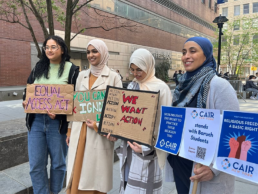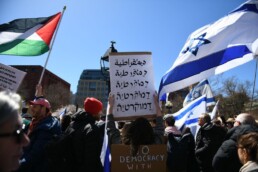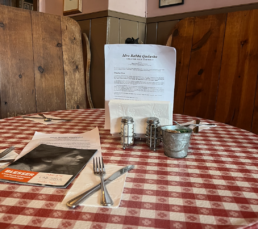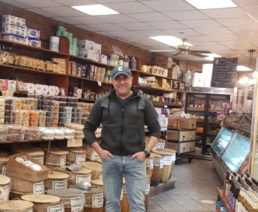Muslim Students Lead Protest for Adequate Prayer Space at New York’s Baruch College
Thursday's protest, coming on the final day of Ramadan, was one of the larger weekly protests students have organized over the past two months.
As published in Religion News Service.
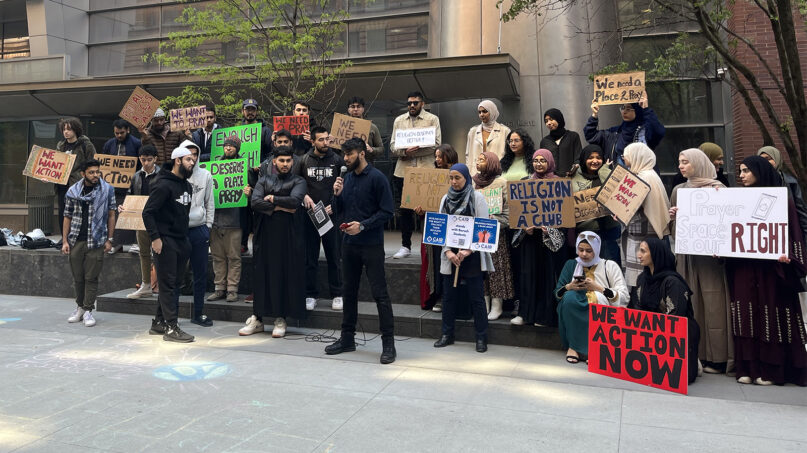
NEW YORK — Loud chants carried through the main plaza at Baruch College in the early afternoon on Thursday (April 20) as a group of around 40 students protested near the Office of Student Life. The students, a majority of them Muslim, were calling on the administration to offer better, more accessible interfaith spaces.
The campus, located a few blocks east of Manhattan’s Madison Square Park, currently offers an interfaith space (room 3-225 in the William and Anita Newman Vertical Campus) that fits around 15 students, and for a college with more than 500 Muslim students, students say the room is not big enough to meet their needs.
“It’s so hard to pray. The room is so small, people end up stepping over each other and it’s a hazard,” said Ayub Tursonzadah, a Muslim student at Baruch College and one of the protest organizers.
Thursday’s protest, coming on the final day of Ramadan, was one of the larger weekly protests students have organized over the past two months. The prayer room was extra crowded during the holy month of fasting and prayer, Muslim students said.
Muslims pray five times a day, and men and women are required to pray separately. With the size limitations of the current interfaith space, the women have had to find other spaces to pray.
“Because of modesty reasons, the women need a private space to pray. We now use the club space allocated to the Women in Islam club. But it’s the size of a closet,” said Zoya Cheema, the president of the Muslim students’ association and one of the student organizers for the protest.
Uswa Anwar, a Muslim student at Baruch, said it has not been easy. She has had to miss parts of classes because she had to wait for her turn to pray. She believes being part of the protest is the only way forward at this point.
“None of us want to be here protesting for this. But we aren’t being heard. We are being brushed aside,” she said.

The effort for better interfaith space began at Baruch last spring when Muslim students first tried to approach administrators at the Office of Student Life to ask for a better prayer space. Students were given a larger interfaith space during the 2021-22 school year while Baruch College was operating remotely. However, toward the end of the spring semester, administrators reassigned the interfaith space back to room 3-225, which, in addition to being small, has ventilation issues, said protesters.
After receiving no responses from the administrative team, a group of Muslim students started praying inside the lobby of student life to silently protest and gather attention during the 2022 fall semester. The students were able to obtain a meeting with Dean Art King, but said they were disappointed with the results.
“We weren’t offered any solutions. We were told this is a Muslim student club issue, but it’s an issue for everyone,” said Tursonzadah.
Though the protests are for interfaith spaces — and have included students of other faiths and no faiths — Muslim students have been at the forefront, largely due to the size of the Muslim population at the college. But being so visible has been nerve-wracking for some.
“We already have such a reputation being Muslim in this country, so we were afraid of how people would perceive us. But we want to stand up for what is right,” said Cheema.
Student organizers have been working with the Council of American Islamic Relations New York, who have worked with students at other City University of New York schools to secure a better interfaith space.
“Baruch College must adhere to the First Amendment right to not discriminate against students of faith. If they provide adequate space for non-religious students, they are obligated to provide the same for religious ones,” said Ahmed Mohamed, the legal director at CAIR New York.
The Baruch protest comes at a time when university administrators across the country have been grappling with how to best accommodate the growing religious diversity on their campuses — from serving halal and kosher food to allowing athletes to wear head coverings. Last year, students at City College, another CUNY school, faced the same issue those at Baruch are currently dealing with and were able to work with administration to secure an interfaith space that works for students.
Elsewhere, the tensions have escalated to lawsuits. California State University has been sued over a new caste discrimination policy with allegations that it singles out Hindu students and staff. Hamline University is being sued over its decision not to renew the contract of an adjunct professor who showed a 14th-century painting of the Prophet Muhammad in her online class last semester.
Kayla Aaron, a Jewish student at Baruch, said she and other Jewish students have faced similar issues as Muslim students when accessing the interfaith space.
“We could not find a place to pray. The room was not big enough. We ended up praying in a public space where people eat their lunches,” said Aaron, describing a time last semester when she and other Jewish students were trying to pray.
Students from non-religious backgrounds have also come out to show their support.
“It’s an important issue and I want to show my support. Having a space for people to congregate creates community, and I am in support of that,” said Matthew Taberas, a student at Baruch.
The administration at Baruch College did not directly respond to yesterday’s protest, but issued a press statement at yesterday’s protest, where they expressed support for the new referendum proposal brought forward by the Undergraduate Student Government executive board last week. The referendum proposes renting an off-campus space for interfaith use that would be funded by a $25 increase in activity fees for full-time students. For the referendum to be considered, the USG board has asked students to sign a proposal for its consideration by end of day Friday.
While some see this as a solution, students at the protest do not.
“Tuition is already an expense for these students, they should not be charging more for students to have a space to pray,” said Rosa Gomez, a Christian student at Baruch College who spoke at the protest yesterday.
Students say they will continue to protest until their needs are met.
“We are going to keep going until we have a space to pray,” said Anwar.
Amid Protests Against Israeli Judicial Reforms, Some American Jews Shift Focus to Occupation
On a recent Sunday, amid a sea of blue and white Israeli flags waving at a Washington Square Park protest against legislation in Israel to undermine the country’s judiciary, a handful of tricolor Palestinian flags stood out.
Among the dozen people who marched with the Palestinian flag was Udi Aloni. A Tel Aviv native, Aloni is a filmmaker who has advocated since he was a teenager for the end of the Israeli presence in the West Bank, the Gaza Strip, and East Jerusalem. For him, fighting for democracy just for Israeli Jews isn’t enough.
“This flag has never been about equality,” he said of the Israeli flags that dominated the rally. “It’s only about equality for Jews, so this flag for me is very problematic.”

Since January, Israelis in large numbers have protested the government’s plan to overhaul the judicial system. The reform, pushed by the new far-right government, has led to a massive backlash in Israel, where thousands of Israelis have taken to the streets. The legislation also threatens the relationship of the Jewish state with American Jews, many of whom also oppose the right-wing tilt of the government.
In New York, protests have been held weekly in the shadow of Washington Square Park’s magnificent arch, coordinated on a 200-person WhatsApp group where activists share tips and announce speakers. Recently, another group has emerged. This splinter-conversation, which includes nearly 80 people, gathers those who think the occupation of Palestinian territories should also be a part of discussions. They hope the growing dissent against the Israeli government will be the first step to a wake-up call regarding the country’s presence in the Palestinian territories since the 1967 war.
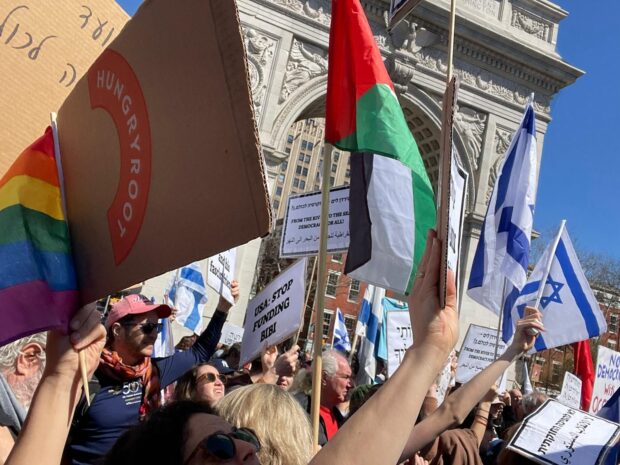
The anti-occupation message is not always welcome at the Washington Square rallies. A few weeks ago, Peter Beinart, a former Zionist who now advocates for a bi-national state, was booed off the rally stage when he started advocating for Palestinian rights. One rally participant recalled people screaming. “It isn’t the right time for this.”
Since the anti-government demonstrations began, protesters have employed the Israeli flag as a symbol of democracy. From New York to Tel Aviv to Israeli settlements in the West Bank considered illegal under international law, the Star of David flag has unified Jewish protesters from different backgrounds. The reform, which has recently been put on pause by the government, is rejected by most Israelis, polls show. Some military reservists, who are essential to Israel’s security, even threatened to stop reporting for duty if the reform was passed. For the pro-democracy side, embracing the flag was a way to reclaim this symbol mainly used by right-wing settlers.
Still, the first time Karin Loevy went to the Washington Square protests, she found herself uncomfortable standing around all these white-and-blue flags. Like the other members of the anti-occupation WhatsApp group, Loevy believes this political crisis offers an occasion to address other undemocratic aspects of the Israeli state.
“For many Palestinians, this flag stands for this long-lasting reality of dispossession. When a Palestinian sees an Israeli flag, especially in this amount, it raises in him the opposite idea of democracy.” This, she said, might explain why few Palestinians join the anti-government rallies in Israel and in New York.
The fight for democracy and the struggle against the occupation are closely linked, Loevy said. She also wrote it down in capital black, green, and red letters on a white cardboard sign: “No Democracy without occupation! Stop apartheid now.”
The term apartheid, a system of institutionalized racial segregation in South Africa from 1948 to the 1990s, has been applied to Israel’s treatment of the Palestinians by the former UN special rapporteur on human rights in Palestinian territories, Michael Lynk. He used it to describe the “dual legal and political system that privileges the 700,000 Israeli Jewish settlers living in the 300 illegal Israeli settlements.” This disputed term is also used to describe the dual reality in which Palestinian and Israeli settlers live within the West Bank, referring, for example, to the existence of a dual highway system.
In a picture taken before the Washington Square Arch, Loevy poses proudly with other Palestinian flag wavers. “USA stops funding Bibi and his fascist friends,” read a sign. (Bibi is short for Benjamin Netanyahu, Israel’s prime minister at the head of the new far-right government.)
Like in the picture, the anti-occupation protesters often stick together, creating a halo of tri-color flags in the protest. What seems anodyne in New York is now banned in Israel after the far-right national security minister, Itamar Ben-Gvir, enforced the prohibition of Palestinian flag-flying in public places. Despite the bill, Palestinian flags can also be seen at anti-government protests in Israel at the hands of anti-occupation protesters.
Waving a Palestinian flag isn’t illegal at New York protests, however those who dare to do so aren’t always received with open arms.
On March 27, a day after Israel’s consul general in New York, Asaf Zamir, resigned in protest over the judicial reform plans, Aloni showed up at a separate demonstration at the Israeli consulate on Second Avenue with a large Palestinian flag tied to the top of a long wooden stick. As protesters marched holding signs with messages like “American Jews wake up” and “DEMOCRACY!” Aloni walked behind them, proudly waving his banner. For about an hour, he paraded in silence under the rain, sparking no other reactions than a few glances.
“I didn’t know if I was a hero or pathetic,” he recalled, laughing. These mild reactions were nothing compared to the turmoil his gesture provoked a few months ago at the Washington Square protest.
“The first time, it was cool. The second time, people were very aggressive,” he said. “They were screaming at me… They almost beat me.” When Aloni unfurled his flag, some other demonstrators asked him to pull it away. Some even said that it would alienate the more centrist and right-wing protesters.
Among those who witnessed the confrontation was Rabbi Misha Shulman, who was born and raised in Israel and now works for the New Shul, a New York-based progressive community that aims to celebrate Judaism through spiritual and cultural events. “It was a very demoralizing moment. For me, the main reason to protest is because (the reform) it’s going to make Palestinians in the West Bank suffer much more than they’re already suffering,” he said.
Shulman recalled that the day of the rally he couldn’t decide what message to wear on his jacket. A half-Palestinian half-Israeli flag? He opted for a toned-down, “Jews and Arabs refuse to be enemies” sign. Shulman was torn between wanting to resist the newly enforced Palestinian flag ban in Israel and his concerns about not alienating his fellow protesters.
But Shulman actually prefers to protest in Israel, which he said felt more “radical” than in New York, where protests were less attended and the stakes were lower. He recalls his feelings of belonging when attending a demonstration in Jerusalem the night Netanyahu fired the defense ministry over criticism of the judicial plan.
“For me, a protest is a type of prayer, and prayer has to be full, real, and pure. So I could say those words and feel like a proper, included participant,” he said.
Growing up in Jerusalem in the 1980s, Shulman learned about Israel as a nation making genuine efforts to achieve peace with its neighbors. His awakening about the reality of occupation has been a long process punctuated by many events. Among them was his military service in the Israeli Defense Force (IDF) in Southern Lebanon from 1996 to 1999, an area occupied by Israel from 1985 to 2000. There he observed the toll of the Arab-Israeli conflict on the local population.
Aloni describes a more brutal process when discussing what he called his unlearning process about Israel. In the late 1990s, he met with Israeli Arab intellectual Azmi Bishara—a decisive encounter. Born in Nazareth, a city populated mainly by Arab Israelis, Bishara founded the Balad party. This Arab political party advocates for Israel to be a binational rather than a Jewish state.
“I think he totally deconstructed my ideological glasses. In a way, he broke them. We all, Israeli Jews, we grew up with them, but we kept it,” explained Udi, who now defines himself as an Israeli Jew who fully supports Palestine. He is also an advocate of a binational state.
The place of Arabs in Israel is a question that divides Israeli, 48% thought “Arabs should be removed from Israel,” according to a 2016 Pew Research Center survey. The “Land for Peace” approach, giving up land for peace, has been the basis of peace agreements since the 1970s. Over the years, the idea that the government should advance the two-state solution has received less support from Israeli Jews (from 44% to 31%) and seems unattainable now that the country controls 61% of the Palestinian territories.
According to a survey from the Israel Democracy Institute, only 32% of Israeli Jews supported a peace agreement between Israel and the Palestinian Authority in 2022.
Aloni, who is now used to heated discussions when he tries to approach the mic holding his Palestinian flag, says it doesn’t matter. Showing up with it is already a good start and a strong symbol. And if the number of flags in the crowd is any indication, support for the anti-occupation cause seems to be growing. “A few weeks ago, there was only one flag,” he said.
He hopes that his presence at these rallies, where only a few questioned Israel’s policy in Palestinian territories, could be the first step to an unlearning process about the occupation.
“I want to be a part of the co-resistance in a dream that will have coexistence at the end,” he added.
‘A Most Beloved Part of Our Service’:The Slow Procession to the Ark in a Sephardic Synagogue
On a January morning at a synagogue on Manhattan’s Upper West Side, Rabbi Ira Rohde, and behind him, Rabbi Dr. Meir Soloveichik, walked slowly toward the front of the building, both dressed in liturgical robes. Rohde carried a two-foot-long scroll draped with a red mantle over one shoulder, gripping the bottom with both hands. The scroll, called the Torah, meaning “instruction” or “teaching” in Hebrew, is the central document for the Jewish people and contains 613 mitzvot — or commandments — from God.
With each step on the red carpet at Congregation Shearith Israel, the rabbi carried the Torah closer and closer to the ark — a wooden chamber, which holds the sacred text, situated on the wall of the synagogue closest to Jerusalem.
When Jewish architect Arnold Brunner designed the synagogue in 1897, he planned a grand entrance facing Central Park, which lies at the building’s eastern end. But after it opened, congregants using the entrance walked in front of the ark and disrupted the service. It’s now rare for anyone to use that door — the congregation instead opts for the more discreet side entrance on West 70th Street.
As Rohde and Soloveichik continued their procession, the choir, seemingly unbothered by the sound of sirens from the street outside, sang in four-part harmony, Mizmor l’david: Havu la’adonai, benei elim, havu la’adonai kavod va’oz. The Hebrew lyrics translate to: “A psalm of David: Prepare for the Lord, [you] sons of the mighty; prepare for the Lord glory and might.”
The choir stood in a semi-circle formation on the balcony above the ark. The choirmaster, Leon Hyman, held his right hand just slightly raised, moving it less than an inch to mark each bar of music that passes. Most of the services at Shearith Israel, like those of Sephardic services generally, are designed to be sung communally. The congregation knew the tune well, and many joined the melody. There’s just one rule here: No one must sing louder than the choir.
For the Jewish people, it is through the Torah that one is connected to God — ritualistically and physically. When Rohde moved along the right side of the synagogue, women sitting on the balcony above moved towards the wooden railings to get closer. The procession toward the ark has always been particularly slow at Congregation Shearith Israel. “This is a most beloved part of our service,” said Rev. Zachary Edinger, when I spoke with him after the service. “One should part from the Torah reluctantly and never with haste.” The custom, he said, stems directly from the halakha, a collective body of Jewish laws that translates to “the path one walks.”
At long last, Rohde ascended the brown marble steps up to the ark chamber. A row of scrolls dressed in green, blue and yellow were visible through its open doors. Rohde lowered the Torah into a space between two others. Together, he and Soloveichik slid the ark doors shut, and the congregation sat.
Teaching Zohar through a Progressive Jewish Lens
Sacred and mystical Jewish texts are usually studied at home or in the synagogue. But on a recent evening in Manhattan, a progressive Jewish community read the Zohar, a text of Jewish mysticism written in the 13th century in Spain, while seated around a checkered tablecloth at Cowgirl, a non-kosher, Texas-style restaurant at 519 Hudson Street. They were celebrating the festival of Tu Bishvat, which marks the awakening of the trees of the Holy Land. Eight members of The New Shul celebrated by ordering fruit-laced drinks.
The New Shul is a progressive Jewish organization founded in 1999 that explores Judaism through a creative, inclusive, and modern lens, said Rabbi Misha Shulman. Tu Bishvat, on the 15th day of the Hebrew month of Shevat, is a minor festival, more often celebrated by the Orthodox community. But on this Saturday evening, The New Shul community recaptured some of the mystical elements of the faith.
Zohar is the text of Jewish mysticism, Shulman said. “It is an Aramaic text of Kabbalah written in the 13th century in Spain.”
The table was filled with sangria, frozen margaritas, red and white wine, a bowl of fried okra, and nachos for everyone to share.
“I brought a bag of fruit for us too,” Shulman said. He then said a blessing over the fruit, took a sip of his sangria and began to read the first page of the stapled packet of Zohar chapters from the Idra Rabba Qadusha (Greater Holy Assembly):
And it is written (Ecclesiastes 5.6): Suffer not your mouth to cause thy flesh to sin.
For neither does the world remain firm, except through secrets. And in worldly affairs there be so great a need for secrets…
One congregant, Susan Meyers, asked: “What is the meaning of secrets here?”
Shulman slightly grinned at the question. “Remember not to read this text too literally,” he said. “Secrets can be interpreted as knowledge that cannot be fully understood by people — the text continues to say that these secrets are ‘matters not even revealed unto the highest angels.’”
One congregant nodded, reassured, as another snapped her fingers in agreement.
It had been nearly 30 minutes of reading and discussing the Zohar. The first round of drinks and appetizers were nearly finished.
The secret of the Lord YHVH is with them that fear Him…
Nina Kaufelt leaned forward and turned her body toward Shulman as she asked, “Why is YHVH written here, instead of Adonai?” Shulman responded that this is a literary text, not prayer, so it was fine to read YHVH aloud.
Those around the table took turns reading aloud, starting to raise their voices as the restaurant filled up.
“It is often said that you shouldn't read Kabbalah until you are 40,” Shulman said glancing meaningfully at Serena Sarch, 27, and me.
In two hours, we had made it halfway through the 12-page packet. Groups of people were constantly filtered in and out of the restaurant. The waiters periodically cleared the table and asked if anyone wanted anything else whenever there was a break in teaching. Shulman ordered another sangria. He finished teaching in the wooden booth beneath a warm-yellow chandelier with carved, deer-shaped antlers, a rustic-framed picture of cowgirls, and a horseshoe.
Druze Faith: A Philosophy Carried From Past to Present
Members of the Druze faith are scattered all over New York City; there is no house of worship where they can meet. Prayer is not central to the Druze religion, which makes a house of worship much less important than for other religions. In the Druze faith, not everyone identifies as religious. There are the initiated, who wear distinct garb and read the holy books, and the uninitiated who do not.
Still, all Druze are connected by their values and beliefs.
“It is a way of life,” said Wassim Malaeb, owner of Samad’s Gourmet, a small deli at Broadway and 111th Street in Manhattan. Malaeb, 54, will eagerly tell you that he is not religious, but he has become an informal teacher of the religion for many students at the nearby Columbia University who have questions about the Druze.
Malaeb is a Lebanese Druze; there are also Druze communities in Syria and Israel. There are fewer than one million members of the Druze faith, only 10 percent of whom are initiated in the faith’s religious practices.
Malaeb is always happy to provide over-the-counter wisdom about his faith. While he’s not formally religious, he says he feels more connected to his faith with every passing year. Still, he describes the Druze faith more as a philosophy than a religion — he says it “summarizes everything.”
A foundational principle of the Druze is the belief in reincarnation. The Druze’s holy book: Kitab al-Hikma, the Book of Wisdom, is only available to religious Druze. Thus, teaching holy scriptures or extensive religious services are not central to the community. You learn these principles through your upbringing, or between the vessels filled with nuts and spices in Samad’s Gourmet.
“Those who remember their past life are people who died too young and are still attached to life,” Malaeb said. He knows of one soul that he met twice in his lifetime, which is his proof that people are reincarnated. The moment of reincarnation is most visible within children: babies that cry are dreaming about their past lives; babies who are born dead are examples of souls that did not transfer.
Malaeb believes that God is within him. This is what allows him to move his body; it is the connection between body and soul. He also believes that this life affects the next — if you have been a good person, your next life will be much easier.
While Malaeb might not remember his own past life; his current life of food service and informal teaching can only mean that he was good in the previous one.

